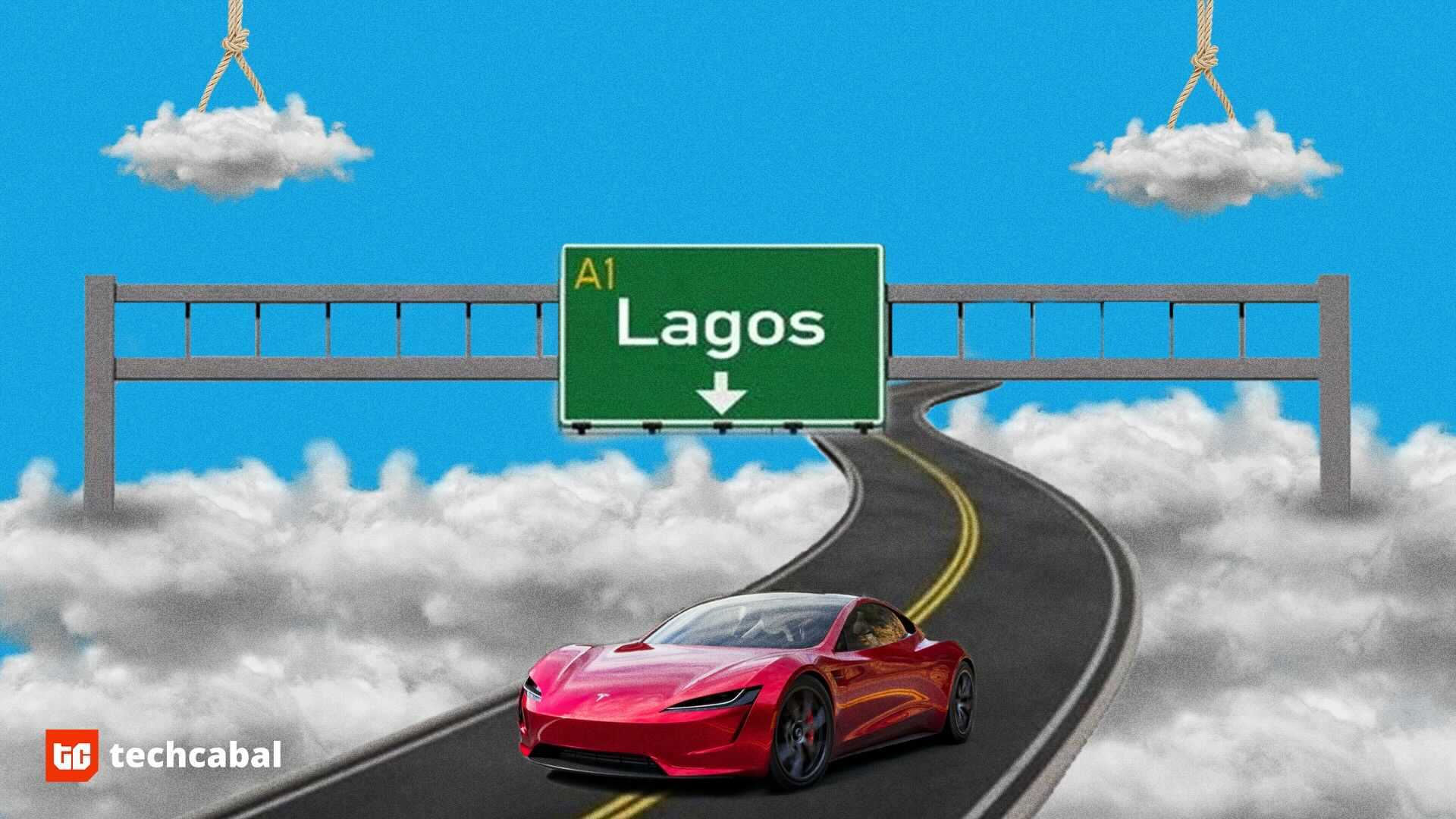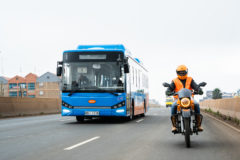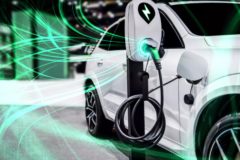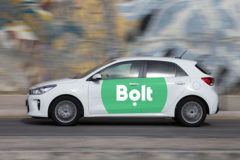Every time a picture of an electric vehicle being driven on African soil shows up on social media, a popular recurring sarcastic comment from many Nigerians is that electric cars generally shouldn’t be used on the continent yet.
This belief was evident in the responses to a recent picture of a Tesla being towed off Lagos’s Third Mainland Bridge. The popular speculation was that the car ran out of power—since, unlike its fossil fuel-powered sibling, it can’t simply be refuelled. Contrary to these speculations, the real cause was a tire blowout.
Granted these remarks hold some merit as many African countries do not have the supporting infrastructure, and very few electric cars are sold in Africa. Tesla, the most renowned electric vehicle (EV) brand globally, sells its vehicles in about 40 countries across 5 continents, except Africa and Antarctica. Other big players in the EV space adopt a similar approach.
But there are signs this will be changing soon. In November 2020, Hyundai unveiled its first Nigerian electric car named Hyundai Kona. Tesla made its first move on the African continent in October 2021 by installing 4150 kW Supercharging stations at the Tangier Al Houara Hilton Resort and the Onomo Hotel in Casablanca, Morocco. In South Africa, tech company Rubicon recently became the official Tesla partner in the country. The agreement currently only covers the company selling Tesla charging infrastructure.
Based on precedents, establishing charging networks is usually the first step Tesla takes before directly selling cars into a market, setting up showrooms and rolling out service centres. The use of charging stations gives a sense of the general demand for Tesla cars.
Tesla, which is currently the market leader, sold almost a million electric cars in 2021. But competition in the EV space is heating up as veteran carmakers, General Motors and Volkswagen, both sold over 200,000 EVs each last year. 118-year-old Ford last year entered the EV race with a rather ambitious target of producing 600,000 EVs by the end of 2023. Rivian—at 9 years—also joined in the race with a market cap of $94 billion, despite having not sold a single car yet.
Answering the big question
While all these moves hint that the expansion of electric car companies to Africa is inevitable, it doesn’t answer the question on many people’s minds: Can electric cars thrive on the African continent?
Alkesh Thavrani, Chief Business Development Officer at fintech startup Bitsika, who owns and drives a Tesla model X around Lagos and neighbouring cities, believes his experience is a testament that electric cars can thrive in Africa.
Thavrani’s Tesla Model X, which costs $90,000, was bought in 2019. The addition of shipping and customs fees (about 70% of the value of the car) brought the cost to about $150,000. The car came with a charger (220-volt outlet adapter) and additionally purchased a home wall charger which cost about $500–600.
Thavrani drives the Tesla to his office and other functions during the week and typically returns to full charge overnight.
“You plug it in at night and by morning you have a full battery, just like you do to your phone,” Oluwatobi Ismail, a Nigerian automotive engineer who runs Smile motors which services the Tesla, said.
Breaking down the charging speed and capacity of the different chargers, he explained that the level one, which is the slowest taking from 18–40 hours to charge to full capacity when empty, provides about 120 volts. The next is the level two, which provides between 208-240 volts, restoring an empty battery life to full in about 8 hours. The fastest is the level three (supercharger) which handles 400 to 900 volts and charges the battery to full capacity in about 30 minutes.
Battery life and mileage of the car
“At full charge, the car can go about 500 km,” Ismail said. It’s slightly less if the air conditioner/heater is used. For context, a trip from Lagos to Ibadan is about 125km. This means the Tesla Model X can complete a round trip on one full charge. He points out that there’s also a mobile charger that can be taken around in the car in case plans change.
Nigerian roads are notorious for traffic jams, so what happens when the car is stuck in traffic? Fortunately, Tesla cars are equipped with regenerative braking, a feature that uses the excess energy produced by a moving vehicle to charge the batteries, thus slowing down the car. Depending on the speed at which the vehicle moves, it can gain back as high as 80% of the energy generated via regenerative braking.
What happens when the battery reaches zero? It’s possible that the car will still drive for a few more kilometers. Different Tesla car owners have reported driving about 16-32km at 0% before their cars come to a final halt—Tesla strongly advises against doing this.
This is possible because just like your smartphone, battery life percentage is an estimation of how much battery is left based on the rate at which the voltage is discharged—the pressure of voltage output is strong when the battery is full and weaker when it’s low. In addition, there are other factors that influence the estimate, this explains why your phone sometimes lasts longer on 1%.
“To put things in perspective, driving from Yaba to Ikoyi is less than 15km. Now with all these in place, you have to be reckless to be stranded due to no battery power,” Ismail said.
Cost charging and maintenance
The maximum household rate of power in Lagos is about ₦32/kWh according to Ikeja distribution company. To estimate how much it costs to charge a Tesla Model X’s battery, we multiply it by the size of the battery: 100 KW. This means the cost of charging the battery fully is ₦3,200 (~$6). This can take the car for a week or two or even a month depending on your driving habits. For Thavrani, when he’s not travelling long distances, he can go a week or two without needing to charge the car
How does this stack up against a fossil fuel-powered car?
“Now if you’re driving a similar fossil fuel-powered car as thirsty as this, you’ll be spending at least ₦15,000 per week on fuel. The tires will wear out faster because it’ll be heavier than this and your car won’t be as fast as this,” Ismail said.
In terms of maintenance, what Ismail has mostly done is inspection so far. “We typically just check the air filters, oil, and shock absorbers. We haven’t had to replace anything apart from tires.”
Notably, the car doesn’t come with spare tires, which Babatunde claims is a common trend in many other new cars. The cost of replacing the Tesla’s tire (20-inch rims) is about ₦110,000 (~$200) for each tire.
When I asked if that wasn’t too expensive, Ismail insisted he thinks it’s fair. He recently bought a tire for ₦330,000 (~$600) for an SUV. “These days I don’t think any tire would cost less than ₦20,000 (~$36.4) and that’s a cheap brand,” he said.
Dealing with accidents and bad roads
Anyone who drives in Lagos knows that it’s nearly impossible to not be hit and scratched by other cars. In the case of Thavrani’s Tesla, most of the incidents have been scratches and dents, which are fixed all at once after they pile up.
Many Lagos roads are notorious for being in bad conditions but Thavrani has found a way to navigate through these bad roads. How? By cleverly adjusting the ride height of the car, a feature that allows the driver to increase or reduce the height of the car from the floor. Bad roads also mean that he’s not able to use the auto-pilot feature except on roads with clearly defined lanes like the Third mainland bridge or Bourdillon, Ikoyi.
About a year ago, there was a major incident that affected the car suspension—the system of tires, tire air, springs, shock absorbers and linkages that connects a vehicle to its wheels and allow relative motion between the two. How easy was that to fix?
“Fixing is straightforward but we don’t have Tesla parts in Ladipo market [a popular market for buying vehicle parts in Lagos] so we had to order parts from Tesla US,” Ismail said. The process of ordering could often be a hassle, he added.
Compared to a similar fossil fuel car, Babatunde believes it’s cheaper to maintain a Tesla.
“I’ll say it’s cheaper to maintain. For a car like this that costs about $90,000, we’d change oil at least two times because it’ll have a V8 engine, each time will cost ₦50,000 (~$90). You’ll change transmission fluid every 2,000km, along the way you’ll have to change the valves and water pump.”
Another thing that counts in favour of the Tesla is that it has fewer moving parts (about 150 parts) compared to a fossil fuel-powered car which has 30,000 parts if you count all parts down to the nuts and bolts. If you consider large parts such as the engine as one part, it comes down to about 1,800 separate parts.
“In a regular car’s engine you have about 200 moving parts, so if you take this out because it doesn’t exist in a Tesla, that’s 200 less things that can break. When you look at your automatic transmission, that’s another 800 less things that can break. So you’ve reduced your problems by like 1,000,” Ismail said.
When I asked him between the Tesla (Electric Vehicles) and fossil fuel-powered cars, which would he recommend, with a straight face before bursting into laughter, he said, “Based on my profession I’ll recommend fossil fuel-powered cars because there are more things to fix and I have to eat.”
A general source of concern for many people about electric cars is the credibility of the technology supporting electric cars, as they aren’t familiar with it. Ismail thinks the technology is nothing new.
“This technology has been around for a long time. It’s been tried, tested and trusted,” he said. “It’s the same technology you have in your hybrid vehicles. Those cars have been around since 2005. They’ve worked so well that’s why they’ve been able to be upgraded into fully electric vehicles. All they’ve done is make the battery bigger.”





















